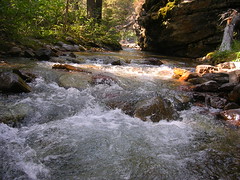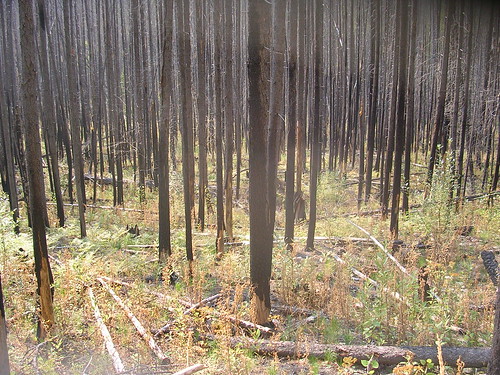Wildfires
Missoula, MT -- Since South Dakota, things have been catching on fire. A cigarette butt will do it, or if it's dry enough, a combine hitting a rock can spark one, but usually lightening starts the land burning.
I drove around with two ranchers during a storm and every time a bolt of lightening hit the horizon they grimaced. The next day was going to be a long one, they told me, of putting out prairie fires. Nothing would burn much that night -- it was raining, after all -- but the few embers that the lightening sparked could keep themselves going over night, and when the wind picked them up in the morning and blew them to some fresh, flammable dry grass, the fires would start.
In Hobson, MT, I woke up in the middle of the night to a blaring siren coming from downtown. Alarmed and bleary-eyed, I walked a few blocks wondering if it was a tornado warning or an air raid siren. It was a fire. Fifteen miles out of town, a haystack had been lit up by a lightening bolt and the siren was to bring everyone who could to come and try to contain the burning. Even the quickest response couldn't salvage the hay -- this rancher will have to buy winter feed for his cattle this year, or if he can't afford that he'll have to sell them.
Over the next week or so in the plains I rode through quite a few blackened, barren patches of land that smelled strongly of charcoal. Range fires move fast because dry grass burns fast. Fires can race across grassland and leave almost nothing behind them. Because of this, though, a contained fire will run out of fuel relatively quickly and burn itself out. Those same embers that may have started the fire, though, need to be watched so that they don't start things up all over again.
A pair of Wyoming brothers told me about one of the first fires they fought, back in their teens when they were barely old enough to be helping out and excited to be there at all. Their detail, though, wasn't exactly thrilling work. They were left in charge of the site after the flames had been extinguished and it was their job to watch and wait and spray any embers that flared up. The two of them had to sit there for hours, they said, before anyone showed up to relieve them.
Forest fires move more slowly than range fires, but that can actually make them harder to contain. A camp fire can burn for several hours, after all. Imagine a campfire made of trees instead of logs. Forest fires are also usually harder to get to than range fires. When a lightening strike starts the mountains burning, the fire can be miles away from the most primitive road, and no one might even notice the fire until it grows. I rode through Glacier National Park last week, and it was scenic in the way it's supposed to be. Snowcapped peaks, blue alpine lakes, bubbling brooks and sweeping, panoramic views. But rather than the clear mountain air I was expecting, I looked at the more distant peaks through a light haze. There had been a big fire a few weeks before I got there and parts of it were still smoldering on the ridge above St. Mary's lake.
I rode through Glacier National Park last week, and it was scenic in the way it's supposed to be. Snowcapped peaks, blue alpine lakes, bubbling brooks and sweeping, panoramic views. But rather than the clear mountain air I was expecting, I looked at the more distant peaks through a light haze. There had been a big fire a few weeks before I got there and parts of it were still smoldering on the ridge above St. Mary's lake.
On my last day in Glacier, I picked out an 8 mile hike on the outskirts of the park, which I was hoping would be a little less crowded than the more central trails. The Northwest part of the McDonald Valley, where my hike to Apgar lookout was, had burned from mid-July of 2003 until the snow started falling that year. Fire crews had it more or less controlled by late August, and they kept it from harming much property or infrastructure, but thousands of acres of forest burned.
It was less crowded, and it was also completely different from the walks through greenery that I had done in the two days before. If the trees had branches, they were curled and blackened. At the base of the trees, though, on the forest floor, ferns and shrubs were green and growing. Some of them, actually, were starting to change color for the fall, and the yellows, oranges and reds doubled as a sign of regrowth and a reminder of the flames that had produced the landscape in the first place.
More than anything, those growing shrubs and bushes were a reminder that forests are supposed to burn. So is rangeland. It's part of a cycle of fire and regrowth that's essential to a healthy landscape. I went to a panel on management of forests before and after fires at the University of Montana here in Missoula and learned plenty about the ways that preventing forests from burning, or even logging a burned area, can alter the ecology of the woods. In New England, nutrients return to the soil when things rot, but out here it takes a fire.
I've talked to several firefighters here in Missoula, earlier on the road, and in a fire camp in Condon, MT, where over a hundred people were involved in fighting a fire in the Swan Mountains, on the Western side of the Rockies. Most of them volunteered to me that by putting them out, every year they were making the fires worse. When the fires aren't allowed to burn, more and more fuel just builds up, and that means that the next fire is that much hotter and that much bigger because it has that much more to burn. "By doing our job, we're creating our job," one of them said.
They were being a bit hard on themselves, though. Speakers presented other factors in why fires have been getting bigger and more frequent. Rising temperatures, for one thing, make snow melt earlier and water evaporate faster, so forests are more susceptible to fire by late in the summer. There's also a developing theory (more data is needed) that forests that have been logged tend to regenerate more densely and with a higher proportion of more flammable species of trees.
Whatever the cause of the increase in fire size and frequency, it's there. This summer, actually, is turning into one of the biggest fire seasons on record. The Great Falls Tribune in Central Montana published a story about it today. And letting the fires burn is becoming less and less of an option as more and more land is developed. Fires that threaten buildings, roads, and other infrastructure (the "urban interface," as it's referred to in wildfire fighting) get priority over ones that don't.
Getting priority, for a fire, is not just an honorary rank. There are very finite resources available for fighting fires and they go where they are thought to be needed most. A limited number of trained firefighters, limited money, limited aircraft, limited heavy equipment. The size of the fire, the level at which it is already contained, and it's threat to property and infrastructure determine what can be put into fighting it. The Tribune article details the stress that US firefighting personnel and resources are under right now. As one would expect, though, where resources are stretched, politics have a lot to do with what gets sent where. One firefighter told me over a beer about how he was shipped away from the Southwest, where a fire was threatening a fairly large number of small towns and mobile homes to Jackson Hole, where a fire was threatening a smaller number of millionaires' mansions. (Including Dick Cheney's, according to him.)
Containing a forest fire so that it doesn't burn down any houses is, like with a range fire, about all that can be hoped for. And to contain a fire, you remove its fuel. A guy who had fought fires in Yellowstone last summer told me about the process of building fire lines. When they approached a fire, they cut the branches off of trees in front of it so that the flames got smaller and smaller as they had less to burn. To finally halt the fire's progress they dug a ditch, only a couple feet wide, down to the mineral soil. By the time it got to the ditch the fire was only a couple feet high because there was so much less for it to burn, and it couldn't get over the ditch to the wood waiting on the other side.
The crew on the Swan Valley fire were excited about a low pressure system coming into the area in the next few days. The fire meteorologists at the National Weather service think it will bring snow, and that's good news for them. Not such good news for me, though. I'm leaving town tomorrow morning and heading into Idaho, out of the mountains, and hopefully away from the snow.

1 comment:
Tychia (my tall genderrific friend who visited Wes a while back and played rugby with us...wait, maybe you were abroad?) is from Missoula and worked on a forest crew!
are you still happy to be biking or are you getting tired of it? i'm in new york now, and i think of you as it's getting chillier here.
Post a Comment